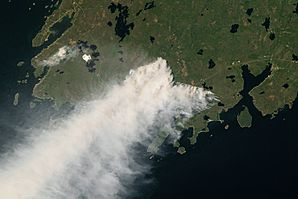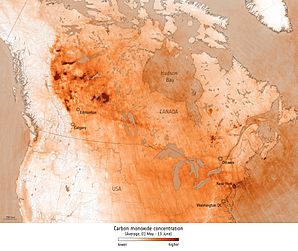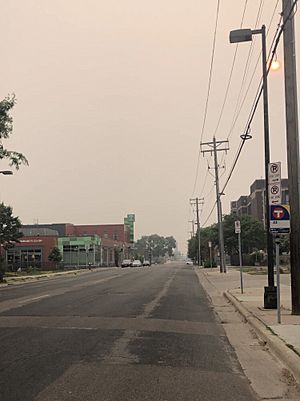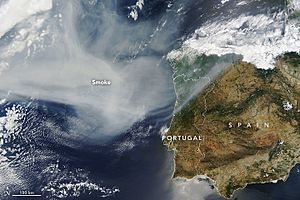2023 Canadian wildfires facts for kids
Quick facts for kids Canadian wildfires of 2023 |
|
|---|---|
|
|
| Location | Canada (all 13 provinces and territories) |
| Statistics | |
| Total fires | 5,765 (as of August 17, 2023) |
| Total area | 13.749 million ha (33.97 million acres) (as of August 17, 2023) |
| Date(s) | March 1, 2023 |
| Deaths | 5 |
| Evacuated | 155,856 people (as of July 7, 2023) |
Beginning in March 2023, and with increased intensity starting in June, Canada has been affected by an ongoing, record-setting series of wildfires. As the worst wildfire season in recorded Canadian and North American history surpassing the record held by the 2020 California wildfires, all thirteen provinces and territories have been affected, with large fires in Alberta, British Columbia, the Northwest Territories, Nova Scotia, Ontario, and Quebec. On June 25, the Canadian Interagency Forest Fire Centre declared the 2023 wildfire season was the worst in Canada's recorded history, surpassing the 1989, 1995, and 2014 fire seasons.
As of August 17, 5,765 fires had burned 13,749,167 hectares (33,974,932 acres), about four percent of the entire forest area of Canada and more than five times the long-term average of 2.38 million ha (5.9 million acres) for that time of the year. Of the 1,062 active wildfires, 671 were deemed "out of control". International aid has helped reduce the impact of the fires.
Smoke emitted from the wildfires has caused air quality alerts and evacuations in Canada and the United States. By late June it had crossed the Atlantic reaching Europe.
Background
In general, since the 1970s and 1980s, the total annual number of wildfires in Canada has decreased while the total area burned has increased, though there is variability between years. Since 1959, the number and size of large fires has increased and the average fire season has become longer by about two weeks. In Canada, wildfire season usually starts in May. The 2023 fires have been compared to the 2016 Fort McMurray wildfire and the 2021 Lytton wildfire.
Due to climate change, weather has been warmer and drier, raising wildfire risk as vegetation is more flammable under these conditions. Wind from a passing cold front during the week of May 18 exacerbated the issues. Canadian Minister of Public Safety Bill Blair said: "These conditions, this early in the season, are unprecedented. Due to climate change, similar extreme weather events may continue to increase in both frequency and severity across our country."
Forest management is also a factor in the wildfires. Because Canada's forest management has focused on fire suppression, dry vegetation has accumulated on the forest floor. Canada has generally stopped performing controlled burns, which help reduce the risk of larger and more dangerous fires. It is difficult to get permission for controlled burns, especially for Indigenous groups who have historically performed them and are disproportionately affected by wildfires. Canada lacks a national firefighting service, and local resources are stretched thin due to budget cuts.
Roughly half of all wildfires in Canada are caused by lightning; due to climate change, lightning strikes and lightning-caused fires are happening more frequently. Lightning-caused fires account for about 85% of land burned. Lightning-caused fires often happen in clusters in remote locations. The other half of wildfires in Canada are human-caused, often unintentionally sparked by things such as discarded cigarette butts, abandoned smouldering campfires, or sparks from braking trains. While false claims of arson have gained traction on social media, arson is generally not a main cause of wildfires in Canada.
Pollution due to a global increase in wildfires has created widespread, long-term impacts on human health. Due to wildfire emissions, Canada broke its record for annual carbon emissions in late June.
Domestic impact
In mid-May, oil companies in Alberta, British Columbia, and Saskatchewan curbed production as a precautionary measure in parts of the provinces; this in turn drove up the price of oil.
International effects
United States
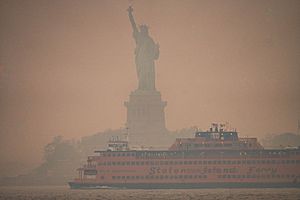
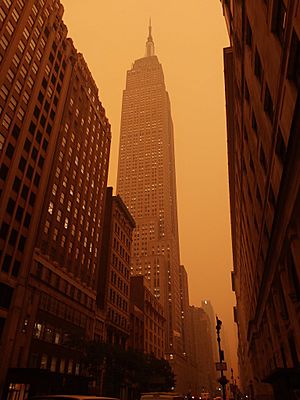
In May, the Minnesota Pollution Control Agency issued several alerts for poor air quality due to smoke from Alberta and Saskatchewan fires and ground-level ozone. Smoke from the Alberta wildfires led to air quality alerts in Colorado, Montana, Nebraska, North Dakota, South Dakota, Utah, Wisconsin, and Washington by May 21, 2023.
On June 2, smoke from the Nova Scotia wildfires affected air quality in Washington, D.C., and the states of Maryland, Pennsylvania, and Virginia. The smoke from wildfires in Quebec drifted into the Northeastern United States on June 5–6 and triggered air quality alerts for most of New York, Connecticut and some of the surrounding states, as well as the Midwestern states of Minnesota, Michigan, and Wisconsin. The smoke on June 6 was estimated by one Stanford researcher to have been the third-worst in the country since 2006. By the night of June 6, New York City had the worst air pollution of any major city in the world; by the morning of June 7 it had fallen to second place, behind Delhi. This also marked the city's worst air quality since the 1960s.
By June 7, air quality alerts also went out to residents in the Delaware Valley in Pennsylvania, New Jersey, and Delaware, and to additional areas in New England. In total, approximately 128 million Americans were under air quality alerts by the evening of June 7. In New York City; Syracuse, New York; Princeton Junction, New Jersey; and the Lehigh Valley in Pennsylvania, the air quality index surpassed 400. After a brief respite, New York City's air quality returned to being the worst of any major city in the world. City officials announced plans to distribute one million N95 masks on June 8.
Several airline flights to and from New York City, New Jersey, and Washington, D.C. were delayed or cancelled; by the afternoon, the Federal Aviation Administration halted all flights going to LaGuardia Airport in New York City, citing visibility concerns.
Schools across New York, New Jersey, and Connecticut announced closures, with the district of schools in Danbury, Connecticut announcing several alerts also advising students. Major League Baseball, the National Women's Soccer League, and the Women's National Basketball Association postponed games scheduled to be held in New York City, New Jersey, and Philadelphia the night of June 7. The Public Theater cancelled its June 8 and 9 Shakespeare in the Park performances of Hamlet. On Broadway, performances of Camelot, Hamilton, and Prima Facie were cancelled due to the poor air quality.
On June 6 and 7, solar farms in the Northeast and Midwest dropped production by around or more than 50% due to the smoke.
On the night of June 7, Connecticut announced a warning advising residents to use masks and stay indoors due to an increase in smoke in the state. Danbury and Greenwich citizens had used masks earlier in the day as well.
On the morning of June 8, air quality was worst throughout the area surrounding Pennsylvania, Washington, D.C., and Trenton, New Jersey. Philadelphia's air quality levels reached their worst levels since 1999. New York City climbed into the worst tier out of the United States Environmental Protection Agency's six-tier air quality index, causing Governor Kathy Hochul to call it an "emergency crisis". Flights continued to be delayed for planes bound for Newark, New York City, and Philadelphia, with delays for Charlotte and Dallas also being eyed. United Airlines issued travel waivers to impacted passengers. Horse racing at Belmont Park in New York was cancelled, causing fears of a potential postponement or cancellation of the Belmont Stakes, scheduled for June 10.
New York City public high schools and the School District of Philadelphia announced they would switch to virtual learning on June 9, due to poor air quality.
By June 11, air quality alerts were still active in New York City, Baltimore, and Philadelphia, but air quality had substantially improved from earlier in the week.
On June 14, an air quality alert was issued for Minnesota due to dangerous air quality levels affecting the state. The air quality in Minneapolis reached 256 at 6pm that day.
On June 27, the smoke spread over the Midwest, causing Chicago to suffer from the worst air quality in the world, reaching 228 AQI. Michigan and Pennsylvania were also affected, and sent out air quality alerts to residents. Air quality alerts were issued for 80 million people in the US.
Europe
The wildfire smoke also drifted to Europe; as of May 23–25, it was mainly located over Scandinavia. On June 8, Iceland and Greenland were affected by drifting smoke, with forecasts suggesting Norway would also be affected over the next few days. As of June 9, smoke in Europe was not dense enough to have harmful effects on health.
On June 25, the smoke reached the Azores; by June 26, it reached Western Europe, specifically France, Portugal, Spain, and the United Kingdom. As the smoke was higher in the atmosphere, it did not affect air quality as it did in the United States, but forecasts predicted it could lead to more vivid sunrises and sunsets and hazy skies.
See also
 In Spanish: Incendios forestales en Canadá de 2023 para niños
In Spanish: Incendios forestales en Canadá de 2023 para niños
- List of disasters in Canada
- List of fires in Canada





